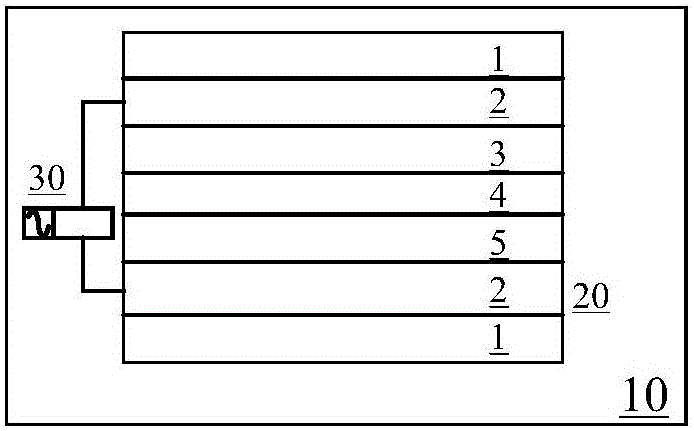High generation efficiency solar cell based on electrochromic device and manufacturing method thereof
An electrochromic device and solar cell technology, applied in the field of solar power generation, can solve the problems of low power generation efficiency of photovoltaic cells and the like
- Summary
- Abstract
- Description
- Claims
- Application Information
AI Technical Summary
Problems solved by technology
Method used
Image
Examples
Embodiment 1
[0068] Assemble the solar cell component 10 and the electric control terminal 20
[0069] Making solar component 10 includes:
[0070] (1) WO 3 Nano film 5 material electrochromic electrode preparation:
[0071] a. Magnetron sputtering a fluorine-doped tin oxide (FTO) film 2 on the surface of tempered glass 1 with a specific size, with a thickness of about 320nm;
[0072] b. Perform high-temperature annealing treatment on it to obtain FTO conductive glass with higher strength, then ultrasonically clean the FTO conductive glass for 15 minutes in the order of ultrapure water, acetone, and ethanol, and dry it for later use; then, use magnetron sputtering method Coating W film on FTO glass with a thickness of 220nm; W film is used as WO 3 a growth source for the nanowires;
[0073] c. Prepare a 0.2mol / L sodium tungstate aqueous solution, then add 3mol / L hydrochloric acid dropwise until no precipitation occurs, and then dissolve the obtained precipitate in hydrogen peroxide to ...
Embodiment 2
[0088] Assemble the solar cell component 10 and the electric control terminal 20
[0089] Making solar component 10 includes:
[0090] (1) WO 3 Nano film 5 material electrochromic electrode preparation:
[0091] a. Magnetron sputtering fluorine-doped tin oxide (FTO) film 2 on the surface of tempered glass 1 with a specific size, with a thickness of about 360nm;
[0092]b. Perform high-temperature annealing treatment on it to obtain FTO conductive glass with higher strength, then ultrasonically clean the FTO conductive glass for 15 minutes in the order of ultrapure water, acetone, and ethanol, and dry it for later use; then, use magnetron sputtering method Coating W film on FTO glass with a thickness of 200nm; W film is used as WO 3 a growth source for the nanowires;
[0093] c. Prepare a 0.2mol / L sodium tungstate aqueous solution, then add 3mol / L hydrochloric acid dropwise until no precipitation occurs, and then dissolve the obtained precipitate in hydrogen peroxide to obt...
Embodiment 3
[0108] Assemble the solar cell component 10 and the electric control terminal 20
[0109] Making solar component 10 includes:
[0110] (1) WO 3 Nano film 5 material electrochromic electrode preparation:
[0111] a. Magnetron sputtering a fluorine-doped tin oxide (FTO) film on the surface of tempered glass 1 with a specific size, with a thickness of about 340nm;
[0112] b. Perform high-temperature annealing treatment on it to obtain FTO conductive glass with higher strength, then ultrasonically clean the FTO conductive glass for 15 minutes in the order of ultrapure water, acetone, and ethanol, and dry it for later use; then, use magnetron sputtering method Coating W film on FTO glass with a thickness of 210nm; W film is used as WO 3 a growth source for the nanowires;
[0113] c. Prepare a 0.2mol / L sodium tungstate aqueous solution, then add 3mol / L hydrochloric acid dropwise until no precipitation occurs, and then dissolve the obtained precipitate in hydrogen peroxide to ob...
PUM
| Property | Measurement | Unit |
|---|---|---|
| thickness | aaaaa | aaaaa |
| thickness | aaaaa | aaaaa |
| thickness | aaaaa | aaaaa |
Abstract
Description
Claims
Application Information
 Login to View More
Login to View More - R&D
- Intellectual Property
- Life Sciences
- Materials
- Tech Scout
- Unparalleled Data Quality
- Higher Quality Content
- 60% Fewer Hallucinations
Browse by: Latest US Patents, China's latest patents, Technical Efficacy Thesaurus, Application Domain, Technology Topic, Popular Technical Reports.
© 2025 PatSnap. All rights reserved.Legal|Privacy policy|Modern Slavery Act Transparency Statement|Sitemap|About US| Contact US: help@patsnap.com

